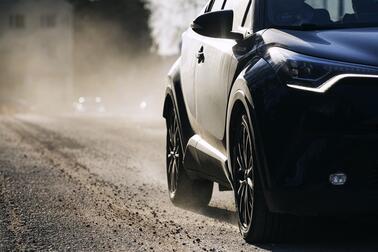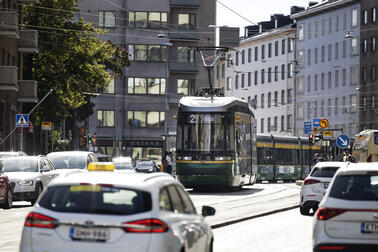
The difference between the proposed ban period and the ending experiment is that the use of vehicles with studded tyres would also be banned in properties. The experiment has previously allowed visiting properties with studded tyres, which made the ban impossible to monitor. For this reason, many motorists using studded tyres have not complied with the ban.
However, the share of studded tyres on Lönnrotinkatu during the ban has decreased from 70% to 45%, and from 70% to 60% at the city level. Since the share of studded tyres on Lönnrotinkatu has been relatively high, the effects on the street's air quality have been minor. In addition, the experiment was hoped to have an even stronger impact on the decline in the share of studded tyres in the whole city.
Lönnrotinkatu is suitable for a studded tyre ban, because there is a clear alternative connection to the street and street dust has been detected by measurements.
The aim is to improve air quality by increasing the share of non-studded winter tyres
Street dust will be an even bigger challenge for Helsinki in the future. The European Union's new Air Quality Directive entered into force at the end of 2024, which has tightened binding limit values for street dust, i.e. inhalable particles. The new limit values must be achieved by 2030 at the latest. At the moment, they would be exceeded in Helsinki in many busy environments, including Lönnrotinkatu. Therefore, the city needs to take effective measures to reach the new limit values.
Since up to half of the street dust comes from asphalt crushed by studded tyres, reducing the use of studded tyres is an effective way to reduce street dust concentrations. The goal set in the City of Helsinki’s Air Quality and Noise Control Plan is to reduce the share of studded tyres to 30% by the winter season 2030–2031. The share of studded tyres has gradually decreased to about 60% in recent years during the experiment and along with increased awareness, but further efforts are needed to reach the target. Now, studded tyres account for around 57% and friction tyres for 43%. The studded tyre charge has been an effective way to reduce the share of studded tyres in Norwegian cities. However, according to current Finnish legislation, a studded tyre charge is not possible.
High concentrations of street dust cause, among other things, respiratory symptoms and infections, and increase the number of asthma and COPD exacerbations requiring hospitalisation. In addition, dust clouds reduce comfort and causes irritation symptoms such as a runny nose and cough, as well as itching and stinging in the throat and eyes. In a survey conducted in the Lönnrotinkatu area, almost a quarter (23%) of the residents indicated that they suffer somewhat or very much from the symptoms caused by street dust in the spring.
According to the survey, 40–50% of residents are positive about the continuation of the studded tyre ban. The attitude is more positive if the responses are weighted by the region's level of car ownership (37% of household-dwellings owned a car in 2022). The studded tyre charge was generally considered a better way to encourage the use of friction tyres compared to a street-specific studded tyre ban.
The aim of the three-year experiment presented for Lönnrotinkatu is to investigate the effectiveness of the tightened studded tyre ban on an increase in the use of friction tyres and air quality, as well as to assess the consequences and overall functionality of the ban. In assessing the extension period for the studded tyre ban experiment, attention is paid to, among other things, compliance with the ban, controllability, the volume of car traffic on alternative routes, the fluency of parking and maintenance traffic, as well as public opinion on the appropriateness of a street-specific studded tyre ban.


